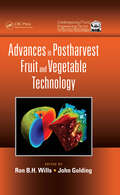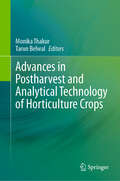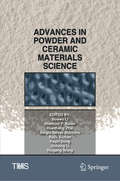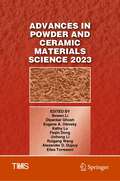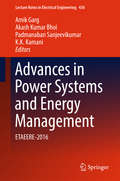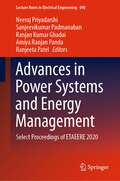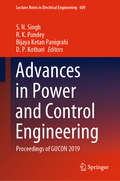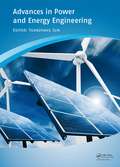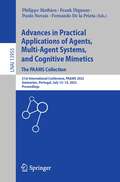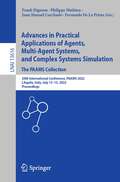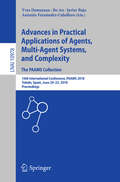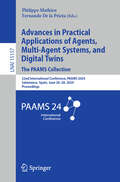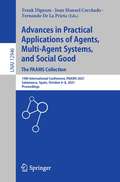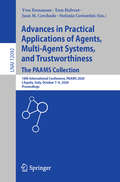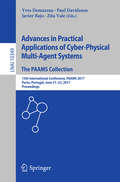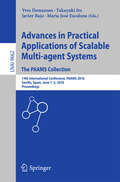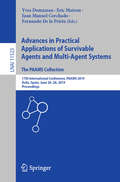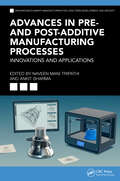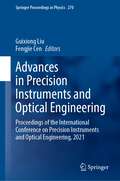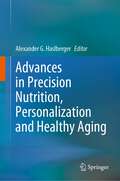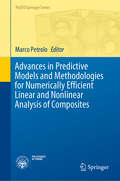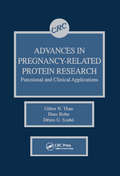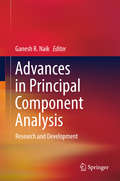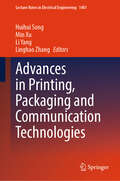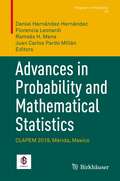- Table View
- List View
Advances in Postharvest Fruit and Vegetable Technology (Contemporary Food Engineering Ser.)
by John Golding Ron B.H. WillsAdvances in Postharvest Fruit and Vegetable Technology examines how changes in community attitudes and associated pressures on industry are demanding changes in the way technology is used to minimize postharvest loss and maintain product quality. In particular, the book discusses important drivers for change, including:Using more natural chemicals
Advances in Postharvest and Analytical Technology of Horticulture Crops
by Monika Thakur Tarun BelwalThis book discusses advances in postharvest and analytical technology for horticulture crops and challenges to meet future needs. The horticulture crops (fruits and vegetables) need a systematic and scientific postharvest handling and management system for securing both physical and chemical attributes while prolonging their shelf life. Postharvest technologies include storage, drying, packaging, extraction of components, and preparation of juice and wine from the collected fruits and vegetables. All these postharvest technologies have emerged and evolved with time to provide meaningful solutions to minimize food loss, maintain quality, and provide fast processing of horticulture crops. Parallel development of analytical techniques has also evolved to monitor the quality of fruits and vegetables during postharvest processing and thus provide a rapid and efficient method for delivering safer food products. This book provides an overview of different postharvest technologies, their mechanisms, and their effect on the quality of horticulture crops. It also emphasizes the assessment of each advanced technology, including its limitations and advantages. Overall, this book provides techniques, research, mechanisms, advances, and challenges of postharvest and analytical technologies for horticulture crops, along with recommendations for future research directions.
Advances in Powder and Ceramic Materials Science (The Minerals, Metals & Materials Series)
by Sergio Neves Monteiro Bowen Li Faqin Dong Shefford P. Baker Huazhang Zhai Rajiv Soman Jinhong Li Ruigang WangThis collection emphasizes the advances of powder and ceramic materials in fundamental research, technology development, and industrial applications. Ceramic materials science covers the science and technology of creating objects from inorganic, nonmetallic materials, and includes design, synthesis, and fabrication of ceramics, glasses, advanced concretes, and ceramic-metal composites.
Advances in Powder and Ceramic Materials Science 2023 (The Minerals, Metals & Materials Series)
by Kathy Lu Bowen Li Faqin Dong Eugene A. Olevsky Jinhong Li Ruigang Wang Dipankar Ghosh Alexander D. Dupuy Elisa TorresaniThis collection emphasizes the advances of powder and ceramic/glass materials in the fundamental research, technology development, and industrial applications. Ceramic materials science covers the science and technology of creating objects from inorganic, non-metallic materials, and includes design, synthesis, and fabrication of ceramics, glasses, advanced concretes, and ceramic-metal composites. In recent years, the hybrids of ceramic and metallic materials have received plenty of interdisciplinary inspirations and achievements in material processes and functional applications including ionic conductors, catalysis, energy conversion and storage, superconductors, semiconductor, filtrations, etc. Topics cover, but are not limited to:· Silicates, oxides, and non-oxide ceramics and glasses · Synthesis, characterization, modeling, and simulation of ceramic materials · Design and control of ceramic microstructure and properties · Ceramic powders and processing · Catalyst and catalyst support materials · Fundamental understanding of ceramic materials and processes · Novel methods, techniques, and instruments used to characterize ceramics and glasses · High entropy ceramics (and/or entropy stabilized, complex-concentrated, compositionally-complex, multi-principal cation ceramics) · Bioceramics, electronic, magnetic ceramics, and applications · Surface treatment and ceramic thin films, membranes, and coatings · Porous ceramic materials · Hybrid systems of ceramic, metal, and/or polymer composites · Ceramics used for extreme environments · Metallurgical byproducts for ceramic manufacturing
Advances in Power Systems and Energy Management: ETAEERE-2016 (Lecture Notes in Electrical Engineering #436)
by Akash Kumar Bhoi Amik Garg Padmanaban Sanjeevikumar K. K. KamaniThis book is a collection of research articles and critical review articles, describing the overall approach to energy management. The book emphasizes the technical issues that drive energy efficiency in context of power systems. This book contains case studies with and without solutions on modelling, simulation and optimization techniques. It covers some innovative topics such as medium voltage (MV) back-to-back (BTB) system, cost optimization of a ring frame unit in textile industry, rectenna for radio frequency (RF) energy harvesting, ecology and energy dimension in infrastructural designs, 2. 4 kW three-phase inverter for aircraft application, study of automatic generation control (AGC) in a two area hydrothermal power system, energy-efficient and reliable depth-based routing protocol for underwater wireless sensor network, and power line communication using LabVIEW. This book is primarily targeted at researchers and senior graduate students, but is also highly useful for the industry professional and scientists.
Advances in Power Systems and Energy Management: Select Proceedings of ETAEERE 2020 (Lecture Notes in Electrical Engineering #690)
by Amiya Ranjan Panda Sanjeevikumar Padmanaban Neeraj Priyadarshi Ranjan Kumar Ghadai Ranjeeta PatelThis book comprises select proceedings of the international conference ETAEERE 2020, and focuses on contemporary issues in energy management and energy efficiency in the context of power systems. The contents cover modeling, simulation and optimization based studies on topics like medium voltage BTB system, cost optimization of a ring frame unit in textile industry, rectenna for RF energy harvesting, ecology and energy dimension in infrastructural designs, study of AGC in two area hydro thermal power system, energy-efficient and reliable depth-based routing protocol for underwater wireless sensor network, and power line communication. This book can be beneficial for students, researchers as well as industry professionals.
Advances in Power and Control Engineering: Proceedings of GUCON 2019 (Lecture Notes in Electrical Engineering #609)
by Bijaya Ketan Panigrahi R. K. Pandey S. N. Singh D. P. KothariThe book features selected high-quality papers presented at the International Conference on Computing, Power and Communication Technologies 2019 (GUCON 2019), organized by Galgotias University, India, in September 2019. Divided into three sections, the book discusses various topics in the fields of power electronics and control engineering, power and energy systems, and machines and renewable energy. This interesting compilation is a valuable resource for researchers, engineers and students.
Advances in Power and Energy Engineering: Proceedings of the 8th Asia-Pacific Power and Energy Engineering Conference, Suzhou, China, April 15-17, 2016
by Yuanzhang SunEnergy and power are playing pivotal roles in social and economic developments of the modern world. Energy and power engineers and technologists have made our lives much more comfortable and affordable. However, due to the demands of the global population on resources and the environment, innovations of more reliable and sustainable energy res
Advances in Practical Applications of Agents, Multi-Agent Systems, and Cognitive Mimetics. The PAAMS Collection: 21st International Conference, PAAMS 2023, Guimarães, Portugal, July 12–14, 2023, Proceedings (Lecture Notes in Computer Science #13955)
by Frank Dignum Paulo Novais Fernando De la Prieta Philippe MathieuThis book constitutes the proceedings of the 21st International Conference on Practical Applications of Agents and Multi-Agent Systems, PAAMS 2023, held in Guimaraes, Portugal, in July 2023.The 32 full papers in this book were reviewed and selected from 70 submissions. 5 demonstration papers are also included in this volume. The papers deal with the application and validation of agent-based models, methods, and technologies in a number of key applications areas, including: advanced models and learning, agent-based programming, decision-making, education and social interactions, formal and theoretic models, health and safety, mobility and the city, swarms and task allocation.
Advances in Practical Applications of Agents, Multi-Agent Systems, and Complex Systems Simulation. The PAAMS Collection: 20th International Conference, PAAMS 2022, L'Aquila, Italy, July 13–15, 2022, Proceedings (Lecture Notes in Computer Science #13616)
by Frank Dignum Juan Manuel Corchado Philippe Mathieu Fernando De La PrietaThis book constitutes the proceedings of the 20th International Conference on Practical Applications of Agents and Multi-Agent Systems, PAAMS 2022, held in L'Aquila, Italy in July 2022.The 37 full papers in this book were reviewed and selected from 67 submissions. Another 10 demonstrations papers were selected from 11 submissions are presented here as short papers. The papers deal with the application and validation of agent-based models, methods, and technologies in a number of key applications areas, including: advanced models and learning, agent-based programming, decision-making, education and social interactions, formal and theoretic models, health and safety, mobility and the city, swarms and task allocation.
Advances in Practical Applications of Agents, Multi-Agent Systems, and Complexity: 16th International Conference, PAAMS 2018, Toledo, Spain, June 20–22, 2018, Proceedings (Lecture Notes in Computer Science #10978)
by Bo An Javier Bajo Antonio Fernández-Caballero Yves DemazeauThis book constitutes the proceedings of the 16th International Conference on Practical Applications of Agents and Multi-Agent Systems, PAAMS 2018, held in Toledo, Spain, in June 2018. The 20 regular and 19 demo papers presented in this volume were carefully reviewed and selected from 57 submissions. They deal with the application and validation of agent-based models, methods, and technologies in a number of key applications areas, such as: energy and security; engineering and tools; evaluation and ethics; negotiation and organisations; personalization and learning; simulation applications; simulation platforms; social networks and humans. The book also contains two invited talks in full paper length.
Advances in Practical Applications of Agents, Multi-Agent Systems, and Digital Twins: 22nd International Conference, PAAMS 2024, Salamanca, Spain, June 26–28, 2024, Proceedings (Lecture Notes in Computer Science #15157)
by Fernando De la Prieta Philippe MathieuThis book constitutes the refereed proceedings of the 22nd International Conference on Practical Applications of Agents and Multi-Agent Systems, PAAMS 2024, held in Salamanca, Spain, during June 26-28, 2024. The 26 full papers and 6 short papers included in this book were carefully reviewed and selected from 64 submissions. The PAAMS 2024 proceedings focus on the development and deployment of agents and multi-agent systems and their real-world applications.
Advances in Practical Applications of Agents, Multi-Agent Systems, and Social Good. The PAAMS Collection: 19th International Conference, PAAMS 2021, Salamanca, Spain, October 6–8, 2021, Proceedings (Lecture Notes in Computer Science #12946)
by Frank Dignum Juan Manuel Corchado Fernando De La PrietaThis book constitutes the proceedings of the 19th International Conference on Practical Applications of Agents and Multi-Agent Systems, PAAMS 2021, held in Salamanca, Spain, in October 2021. The 27 regular and 13 short papers presented in this volume were carefully reviewed and selected from 56 submissions. They deal with the application and validation of agent-based models, methods, and technologies in a number of key applications areas, including: advanced models and learning, agent-based programming, decision-making, education and social interactions, formal and theoretic models, health and safety, mobility and the city, swarms and task allocation.
Advances in Practical Applications of Agents, Multi-Agent Systems, and Trustworthiness. The PAAMS Collection: 18th International Conference, PAAMS 2020, L'Aquila, Italy, October 7–9, 2020, Proceedings (Lecture Notes in Computer Science #12092)
by Yves Demazeau Juan M. Corchado Stefania Costantini Tom HolvoetThis book constitutes the proceedings of the 18th International Conference on Practical Applications of Agents and Multi-Agent Systems, PAAMS 2020, held in L'Aquila, Italy, in October 2020.The 29 regular and 17 demo papers presented in this volume were carefully reviewed and selected from 64 submissions. They deal with the application and validation of agent-based models, methods, and technologies in a number of key applications areas, including: advanced models and learning, agent-based programming, decision-making, educa-tion and social interactions, formal and theoretic models, health and safety, mobility and the city, swarms and task allocation.
Advances in Practical Applications of Cyber-Physical Multi-Agent Systems: The PAAMS Collection: 15th International Conference, PAAMS 2017, Porto, Portugal, (Lecture Notes in Computer Science #10349)
by Javier Bajo Yves Demazeau Zita Vale Paul DavidssonThis book constitutes the refereed proceedings of the 15th International Conference on Practical Applications of Scalable Multi-Agent Systems, PAAMS 2017, held in Porto, Portugal, in June 2017. The 11 revised full papers, 11 short papers, and 17 Demo papers were carefully reviewed and selected from 63 submissions. The papers report on the application and validation of agent-based models, methods, and technologies in a number of key application areas, including day life and real world, energy and networks, human and trust, markets and bids, models and tools, negotiation and conversation, scalability and resources.
Advances in Practical Applications of Scalable Multi-agent Systems. The PAAMS Collection: 14th International Conference, PAAMS 2016, Sevilla, Spain, June 1-3, 2016, Proceedings (Lecture Notes in Computer Science #9662)
by Takayuki Ito Javier Bajo Yves Demazeau Maria José EscalonaThis book constitutes the refereed proceedings of the 14th International Conference on Practical Applications of Scalable Multi-agent Systems, PAAMS 2016, held in Sevilla, Spain, in June 2016. The 9 revised full papers, 10 short papers, and 16 Demo papers were carefully reviewed and selected from 58 submissions (39 full paper and 19 Demo paper submissions. The papers report on the application and validation of agent-based models, methods, and technologies in a number of key application areas, including day life and real world, energy and networks, human and trust, markets and bids, models and tools, negotiation and conversation, scalability and resources.
Advances in Practical Applications of Survivable Agents and Multi-Agent Systems: 17th International Conference, PAAMS 2019, Ávila, Spain, June 26–28, 2019, Proceedings (Lecture Notes in Computer Science #11523)
by Juan Manuel Corchado Yves Demazeau Fernando De la Prieta Eric MatsonThis book constitutes the proceedings of the 17th International Conference on Practical Applications of Agents and Multi-Agent Systems, PAAMS 2019, held in Ávila, Spain, in June 2019. The 19 regular and 14 demo papers presented in this volume were carefully reviewed and selected from 55 submissions. They deal with the application and validation of agent-based models, methods, and technologies in a number of key applications areas, including: Agronomy and Internet of Things, coordination and structure, finance and energy, function and autonomy, humans and societies, reasoning and optimization, traffic and routing.
Advances in Pre- and Post-Additive Manufacturing Processes: Innovations and Applications (Innovations in Smart Manufacturing for Long-Term Development and Growth)
by Naveen Mani Tripathi and Ankit SharmaThis book provides knowledge about the process of creating and designing products based on an Industry 4.0 setting. The fundamentals of Additive Manufacturing, its many technologies, the process parameters, advantages, limitations, and recent developments are discussed. In addition, the most recent post-additive manufacturing process advancements, surface quality defects, and challenges are the primary topics that will be investigated in the book. Advances in Pre- and Post-Additive Manufacturing Processes: Innovations and Applications provides scientific and technological insights into the physical fundamentals of the machining and finishing processes in macro, micro, and nanoscales. It explores in a systematic way both conventional and unconventional material-shaping processes with various modes of hybridization concerning theory modelling and industrial potential. It focuses on the applications of Additive Manufacturing that are linked to pre-stage and post-stage processes and encompasses a broad spectrum of macro, micro, and nano-processes that are utilized in manufacturing activities. The book goes on to cover a wide range of reliable and economical fabrication of metallic parts with complicated geometries which are of considerable interest to the aerospace, medical, automotive, tooling, and consumer products industries. This reference title encapsulates the current trends of today’s material development and machining techniques for advanced composite materials, making it a one-stop resource for academic researchers and industrial firms while they are formulating strategic development strategies. It also serves as a reference book for students at all levels of education, from undergraduates to doctoral candidates.
Advances in Precision Instruments and Optical Engineering: Proceedings of the International Conference on Precision Instruments and Optical Engineering, 2021 (Springer Proceedings in Physics #270)
by Guixiong Liu Fengjie CenThis book highlights the new technologies and applications presented at the 2021 International Conference on Precision Instruments and Optical Engineering held in Chengdu, China from 25 to 27 August 2021. The conference aimed to provide a platform for researchers and professionals to share research findings, discuss cutting-edge technologies, promote collaborations and fuel the industrial transition of new technologies. The invited and contributed papers covered recent developments in optoelectronic devices, nanophotonic research, optoelectronic materials, precision instruments, intelligent instruments, laser technology, optical spectroscopy and other optical engineering topics. The book is intended for researchers, engineers and advanced students interested in precision instruments and optical engineering and their applications in diverse fields.
Advances in Precision Nutrition, Personalization and Healthy Aging
by Alexander G. HaslbergerThis book provides an overview on current trends and developments in precision nutrition and personalized health preservation, focussing on a field which is undergoing rapid change. Today, personalized strategies contrast generally accepted guidelines for specified groups and improved health and disease markers are shifting health care toward preventive strategies. At the same time, advances in food additives, nutraceuticals, functional, and medical foods are breaking down the traditional domains of health-related disciplines. This book aims to provide an overview on these processes, discusses arising problems, and provides an outlook on the future of personalized health care and the role of precision nutrition. It covers preliminary thoughts on what has been achieved and focusses on developments in the area of metabolic diseases, aging, and neurology. The book is intended as a primer in the field of precision nutrition and is aimed at researchers, clinicians, and students in health-related disciplines, who would like to get insights into current trends and developments in this area
Advances in Predictive Models and Methodologies for Numerically Efficient Linear and Nonlinear Analysis of Composites (PoliTO Springer Series)
by Marco PetroloThis book gathers contributions addressing issues related to the analysis of composite structures, whose most relevant common thread is augmented numerical efficiency, which is more accurate for given computational costs than existing methods and methodologies. <P><P>It first presents structural theories to deal with the anisotropy of composites and to embed multifield and nonlinear effects to extend design capabilities and provide methods of augmenting the fidelity of structural theories and lowering computational costs, including the finite element method. <P><P> The second part of the book focuses on damage analysis; the multiscale and multicomponent nature of composites leads to extremely complex failure mechanisms, and predictive tools require physics-based models to reduce the need for fitting and tuning based on costly and lengthy experiments, and to lower computational costs; furthermore the correct monitoring of in-service damage is decisive in the context of damage tolerance. <P><P>The third part then presents recent advances in embedding characterization and manufacturing effects in virtual testing. The book summarizes the outcomes of the FULLCOMP (FULLy integrated analysis, design, manufacturing, and health-monitoring of COMPosite structures) research project.
Advances in Pregnancy-Related Protein Research Functional and Clinical Applications
by Gabor N. Than H. Bohn Denes G. SzaboAdvances in Pregnancy-Related Protein Research describes the most significant advances in pregnancy-related protein research that have occurred over the last 25 years. The fetal, pregnancy, placental, and endometrial proteins discussed are classified by their origin and biological activity. The structure and function of newly discovered pregnancy protein families are examined in detail. Physiological values of various pregnancy and placental proteins are presented, and the pathophysiological significance of diagnostic and therapeutic data is addressed. Advances in Pregnancy-Related Protein Research will be a useful reference for obstetricians, oncologists, immunologists, reproduction specialists, oncodevelopmental biologists, gynecologists, and other researchers interested in the subject.
Advances in Principal Component Analysis: Research and Development
by Ganesh R. NaikThis book reports on the latest advances in concepts and further developments of principal component analysis (PCA), addressing a number of open problems related to dimensional reduction techniques and their extensions in detail. Bringing together research results previously scattered throughout many scientific journals papers worldwide, the book presents them in a methodologically unified form. Offering vital insights into the subject matter in self-contained chapters that balance the theory and concrete applications, and especially focusing on open problems, it is essential reading for all researchers and practitioners with an interest in PCA.
Advances in Printing, Packaging and Communication Technologies (Lecture Notes in Electrical Engineering #1401)
by Min Xu Li Yang Linghao Zhang Huihui SongThis book includes original, peer-reviewed research papers from the 15th China Academic Conference on Printing and Packaging (CACPP 2024), held in Tianjin, China on November 14-16, 2024. The proceedings cover the latest findings in color science and technology, image processing technology, digital media technology, mechanical and electronic engineering and numerical control, materials and detection, printing and packaging technology, and so on. As such, the book is of interest to university researchers, R&D engineers and graduate students in the fields of color science, image science, materials science, computer science, digital media, network technology, smart manufacturing technology and printing and packaging.
Advances in Probability and Mathematical Statistics: CLAPEM 2019, Mérida, Mexico (Progress in Probability #79)
by Daniel Hernández-Hernández Ramsés H. Mena Florencia Leonardi Juan Carlos Pardo MillánThis volume contains papers which were presented at the XV Latin American Congress of Probability and Mathematical Statistics (CLAPEM) in December 2019 in Mérida-Yucatán, México. They represent well the wide set of topics on probability and statistics that was covered at this congress, and their high quality and variety illustrates the rich academic program of the conference.
